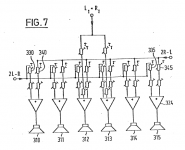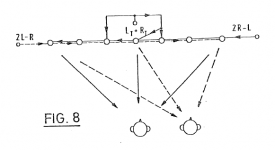I've just re-read the article and I think the delay line is a misnomer. I think it reads that the FR and polar response of the drivers is altered. There was a follow-up letter to the article a couple of months later (WW sent it to me when I requested the original article, years ago). This describes a single, 8 foot long box "Along this length and facing forward were placed five 6.5 inch high-compliance type speakers, with small centre cones … a purely resistive division was used between each speaker. The result is similar to the centre channel technique …
I think that makes a lot more sense. The resistive links would be a form of level tapering that would improve the polar response and would also get around the issue of one amplifier shorting the other. By "centre channel technique" I assume they mean like a 3 channel approach with resistors from L & R feeding the center channel, but in this case it would be split 5 ways rather than 3.
I'm not sure if this advances this thread. Rather than debate whether Jordan achieved it in 1971, it might be more interesting to see what can be done using computer techniques.
I think the One Limited (Hooley) paper shows much of what can be done with computer techniques. With a large array of drivers and a fine pitch from center to center you can create a broad range polar pattern in about any shape desired. They even give the user real time control for aiming the beams around during setup.
The One Limited intent is 5 channels in one box but you could use the technology for other things such as a nice surround only array, or front channels with purpose designed polar response. If you are familiar with Ken Kantors Magic (AR) speaker, you could define a more sophisticated version of that with a primary undelayed beam and multiple steered and delayed beams that mimiced the early reflections of an ideal concert hall.
Interesting stuff,
David S.
Hi David - I think the follow-up letter is referring to the centre channel technique in Jordan's article; which used two speakers back-to-back in the centre, relying on their off-axis HF roll off. He also describes a much earlier GEC system which had a single, forward-facing driver playing a mono signal at lower level than the LR speakers.
I'll have a look at the One Limited paper. It's of academic interest to me rather than any plans for a practical project. But very interesting.
I'll have a look at the One Limited paper. It's of academic interest to me rather than any plans for a practical project. But very interesting.
Rather than debate whether Jordan achieved it in 1971, it might be more interesting to see what can be done using computer techniques.
OTOH what Jordan achieved in 1971 is interesting from our diy perspective because it probably could be diyable today - which cannot be said about modern computer techniques - from our diy perspective they remain - as You have rightly put it:
of academic interest ... rather than any plans for a practical project.
I'd have thought the average PC could work up something like this, or possible use some of the digital processing units now available to the DIYer.
But I can't help on that or the inductor fashioned idea - I'd be more inclined to take Ted Jordan's word for it and experiment further with the vertical arrays, which he said are superior anyway.
But I can't help on that or the inductor fashioned idea - I'd be more inclined to take Ted Jordan's word for it and experiment further with the vertical arrays, which he said are superior anyway.
very interesting approach for home cinema. Are there such loudspeakers available as commercial devices?45 degrees curvature to the back? sounds familiar... yes - now it's more clear, it sounds just like CBT of Don Keele!
now read this:
wow! doesn't it look familiar?
An externally hosted image should be here but it was not working when we last tested it.
the curvature and power tapering in CBT array are just instead of a proper delay line
looks like old uncle Ted outsmarted the gurus of today as early as in 1971
outsmarted because He showed how to make such horizontal array for stereo not just for center channel speaker
are You sure? it seems that delay should be calculated assuming the speed of sound, and when the center-to-center spacing is around 10-12 cm (small Jordan speakers like JX53 allow even for just 7.5 cm c-t-c spacing) all that is needed is just around 0.3 ms of delay between the adjoining drivers
now, is it really huge and unobtainable with passive analog circuitry?
it surely can be done with active analog circuitry so why not with passive?
I think the delay is intended only for frequencies which generate stereo ITD cues meaning below about 1kHz.
If driver c-c spacing is 12 cm and we like to generate +/- 30 degree angle plane waves for a stereo triangle the required delay is about 175 us. Feasible ? Yes.
Japanese description says just that the drivers: "are all connected to different networks"

This is interesting
The idea of using cabinet hinged doors to direct high freq energy to the room was not new at that time but originates from several decades before Jordan.
Found a patent for the system that I remember having read about (in German though):
Arrangement for the acoustic reproduction of signals, presented by means of a right and a left stereo-channel.
Jordan is also mentioned. I wonder how they achieved the delay in these days.
Nice find. However this patent is not Jordan's.
What is most interesting in this patent is Figures 7 and 8 !
Take a look !
It's a stereo matrix with x = 0.5
Two decades later Miles arrived in same conclusion about matrix with x = 0.5:
AES Preprint: "An Optimum Linear-Matrix Stereo Imaging System"
As did I with my SSS protos:
Elias Pekonen Home Page - Stereophonic Sound from a Single Speaker
Reinvent accomplished !
Long live the matrix stereo !
- Elias
Attachments
Was? I thought he was still with us. Can no-one ask him about it? Although I have met him several times (I even painted some of his house), I wouldn't feel competent to to do so myself.Jordan was a good driver designer and seemed to know his way pretty well around a woofer equivalent circuit. He designed products that enthusiasts still love. That he wasn't much of a network designer and didn't understand delay lines is perfectly okay.
David S.
Was? I thought he was still with us. Can no-one ask him about it? Although I have met him several times (I even painted some of his house), I wouldn't feel competent to to do so myself.
Ring him up? ask him to come on and write a comment??
He may be unaware of this forum...
Let him know he can always post without revealing his true identity, should he prefer that?
_-_-bear
Ted knows about the forum although probably not this particular discussion. AFAIK he doesn't join in forums. He's pretty busy right now with developing a new drive unit and getting it into production.
As I mentioned before, I never got to hear the full horizontal array but did try the reflector idea, which worked OK.
How did Quad do the delay lines in their ESL57? That was done with passive components, wasn't it?
As I mentioned before, I never got to hear the full horizontal array but did try the reflector idea, which worked OK.
How did Quad do the delay lines in their ESL57? That was done with passive components, wasn't it?
I just tried my own version of the delay line. Six identical full range CD speakers spaced evenly across the front of my listening room. Each speaker contained a signal from both channels. For instance, the leftmost speaker would have the normal left channel with a delayed and attenuated right channel signal. The amount of added delay between speakers was equal to the distance. The speakers were 1.6 feet apart and the delay between them was about 1.6 msec. I played with various attenuations between speakers from 0 to 3 dB. I actually found one configuration that sounded quite good. It was when I accidentally turned off all the speakers except the leftmost and the rightmost. It was a quick and crude test but it didn't encourage me to persue the idea further.
- Status
- This old topic is closed. If you want to reopen this topic, contact a moderator using the "Report Post" button.
- Home
- Loudspeakers
- Multi-Way
- E. J. Jordan Delay Line

